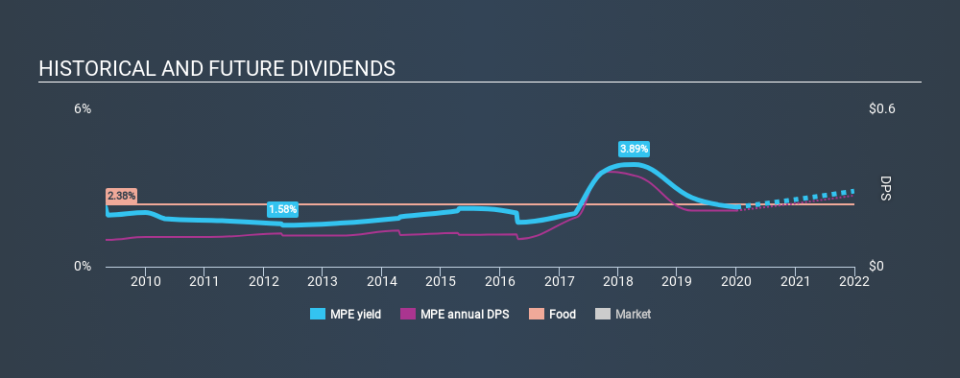M.P. Evans Group plc (LON:MPE) Investors Should Think About This Before Buying It For Its Dividend

Could M.P. Evans Group plc (LON:MPE) be an attractive dividend share to own for the long haul? Investors are often drawn to strong companies with the idea of reinvesting the dividends. If you are hoping to live on the income from dividends, it's important to be a lot more stringent with your investments than the average punter.
A slim 2.3% yield is hard to get excited about, but the long payment history is respectable. At the right price, or with strong growth opportunities, M.P. Evans Group could have potential. There are a few simple ways to reduce the risks of buying M.P. Evans Group for its dividend, and we'll go through these below.
Click the interactive chart for our full dividend analysis
Payout ratios
Dividends are usually paid out of company earnings. If a company is paying more than it earns, then the dividend might become unsustainable - hardly an ideal situation. Comparing dividend payments to a company's net profit after tax is a simple way of reality-checking whether a dividend is sustainable. Although M.P. Evans Group pays a dividend, it was loss-making during the past year. When a company is loss-making, we next need to check to see if its cash flows can support the dividend.
Unfortunately, while M.P. Evans Group pays a dividend, it also reported negative free cash flow last year. While there may be a good reason for this, it's not ideal from a dividend perspective.
Is M.P. Evans Group's Balance Sheet Risky?
Given M.P. Evans Group is paying a dividend but reported a loss over the past year, we need to check its balance sheet for signs of financial distress. A quick check of its financial situation can be done with two ratios: net debt divided by EBITDA (earnings before interest, tax, depreciation and amortisation), and net interest cover. Net debt to EBITDA is a measure of a company's total debt. Net interest cover measures the ability to meet interest payments. Essentially we check that a) the company does not have too much debt, and b) that it can afford to pay the interest. M.P. Evans Group has net debt of 1.14 times its EBITDA, which we think is not too troublesome.
We calculated its interest cover by measuring its earnings before interest and tax (EBIT), and dividing this by the company's net interest expense. M.P. Evans Group has EBIT of 5.37 times its interest expense, which we think is adequate.
We update our data on M.P. Evans Group every 24 hours, so you can always get our latest analysis of its financial health, here.
Dividend Volatility
From the perspective of an income investor who wants to earn dividends for many years, there is not much point buying a stock if its dividend is regularly cut or is not reliable. M.P. Evans Group has been paying dividends for a long time, but for the purpose of this analysis, we only examine the past 10 years of payments. Its dividend payments have fallen by 20% or more on at least one occasion over the past ten years. During the past ten-year period, the first annual payment was US$0.10 in 2010, compared to US$0.21 last year. Dividends per share have grown at approximately 7.7% per year over this time. The growth in dividends has not been linear, but the CAGR is a decent approximation of the rate of change over this time frame.
Dividends have grown at a reasonable rate, but with at least one substantial cut in the payments, we're not certain this dividend stock would be ideal for someone intending to live on the income.
Dividend Growth Potential
Given that the dividend has been cut in the past, we need to check if earnings are growing and if that might lead to stronger dividends in the future. M.P. Evans Group's EPS have fallen by approximately 23% per year during the past five years. With this kind of significant decline, we always wonder what has changed in the business. Dividends are about stability, and M.P. Evans Group's earnings per share, which support the dividend, have been anything but stable.
Conclusion
When we look at a dividend stock, we need to form a judgement on whether the dividend will grow, if the company is able to maintain it in a wide range of economic circumstances, and if the dividend payout is sustainable. We're a bit uncomfortable with M.P. Evans Group paying a dividend while loss-making, especially since the dividend was also not well covered by free cash flow. Second, earnings per share have been in decline, and its dividend has been cut at least once in the past. Using these criteria, M.P. Evans Group looks quite suboptimal from a dividend investment perspective.
Are management backing themselves to deliver performance? Check their shareholdings in M.P. Evans Group in our latest insider ownership analysis.
If you are a dividend investor, you might also want to look at our curated list of dividend stocks yielding above 3%.
If you spot an error that warrants correction, please contact the editor at editorial-team@simplywallst.com. This article by Simply Wall St is general in nature. It does not constitute a recommendation to buy or sell any stock, and does not take account of your objectives, or your financial situation. Simply Wall St has no position in the stocks mentioned.
We aim to bring you long-term focused research analysis driven by fundamental data. Note that our analysis may not factor in the latest price-sensitive company announcements or qualitative material. Thank you for reading.

